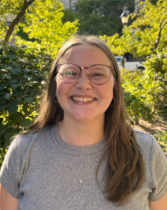Students
Molecular Biophysics Training Program Appointees
(2025-2026)
 Kristen (Nikki) Amarillo
Kristen (Nikki) Amarillo
Christensen Lab, 2nd year IBiS student
Investigating the Effect of Dynactin Composition on its Diverse Cellular Roles
Nikki is studying how dynactin, an essential multi-subunit cofactor for the motor protein dynein, affects microtubule dynamics.
 Jackson Boodry
Jackson Boodry
Shrinivas Lab, 2nd year ChBE student
Developing biophysical models to probe ensemble-derived functions of intrinsically disordered proteins
Jackson works on developing efficient physics-based computational approaches for the design of functional intrinsically disordered proteins.

Miranda Flores Escobar
Christensen Lab, 3rd year IBiS student
Functional Role of Aps Proteins on Dynein Activation and Coordinated Nuclear Movement
Miranda is investigating how the potential dynein adaptors—ApsA, ApsB, and ApsC—activate and regulate multiple dynein motor complexes to drive nuclear transport within Aspergillus nidulans.

Irving Francisco
Vafabakhsh Lab, 3rd year IBiS student
Biophysical investigation of the nucleolus assembly
Biophysical studies on the principles governing nucleolus assembly during mitosis.
 Karen Gomez
Karen Gomez
Ziarek Lab, 3rd year DGP student
Biophysical Approaches to Selectively Modulating NTSR1 for Substance Use Disorder
Karen aims to create a framework for engineering pharmacologically distinct GPCR ligands to explore broader mechanisms of allosteric modulation.
 Lydia Kenney
Lydia Kenney
Pinkett Lab, 3rd year IBiS student
Investigating the Roles of Accessory Domains as Regulators of Bacterial ATP-Binding Cassette (ABC) Transporters Through Biophysical and Structural Characterization
Lydia is studying the ProU osmoregulatory ATP-binding cassette (ABC) transporter from Yersinia pestis and its cystathionine-ß-synthase (CBS) regulatory domain using structural biology and biochemistry techniques like cryo-EM, EPR spectroscopy, and transport assays.
 Sarah Keuning
Sarah Keuning
Du Lab, 2nd year IBiS student
Structural and functional investigation of human CALHM2 under native conditions
Sarah is studying the structural and functional characteristics of human calcium homeostasis modulator 2 (CALHM2), a recently identified, extracellular Ca2+-inhibited ion channel implicated in an array of neurological disorders. She is using both cryo-EM and electrophysiology to investigate the role of physiological temperature and the native lipid environment in regulating CALHM2’s function and gating mechanism.
 Adun Obisesan
Adun Obisesan
Rocklin Lab, 3rd year IBiS student
Determining design rules for miniproteins with high folding stability and low hydrophobicity
Adun works on using high-throughput and computational approaches for designing proteins to be highly stable and active across a wide range of conditions.
